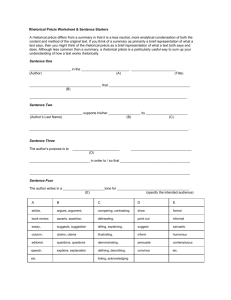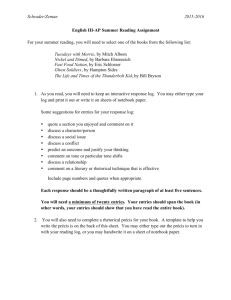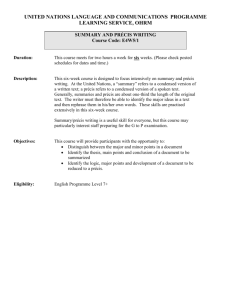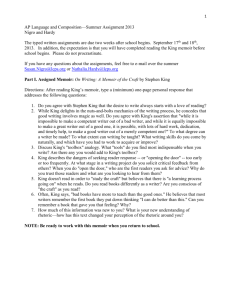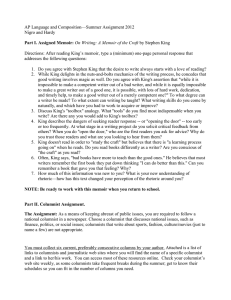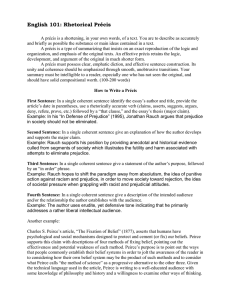Follow a Columnist Packet
advertisement
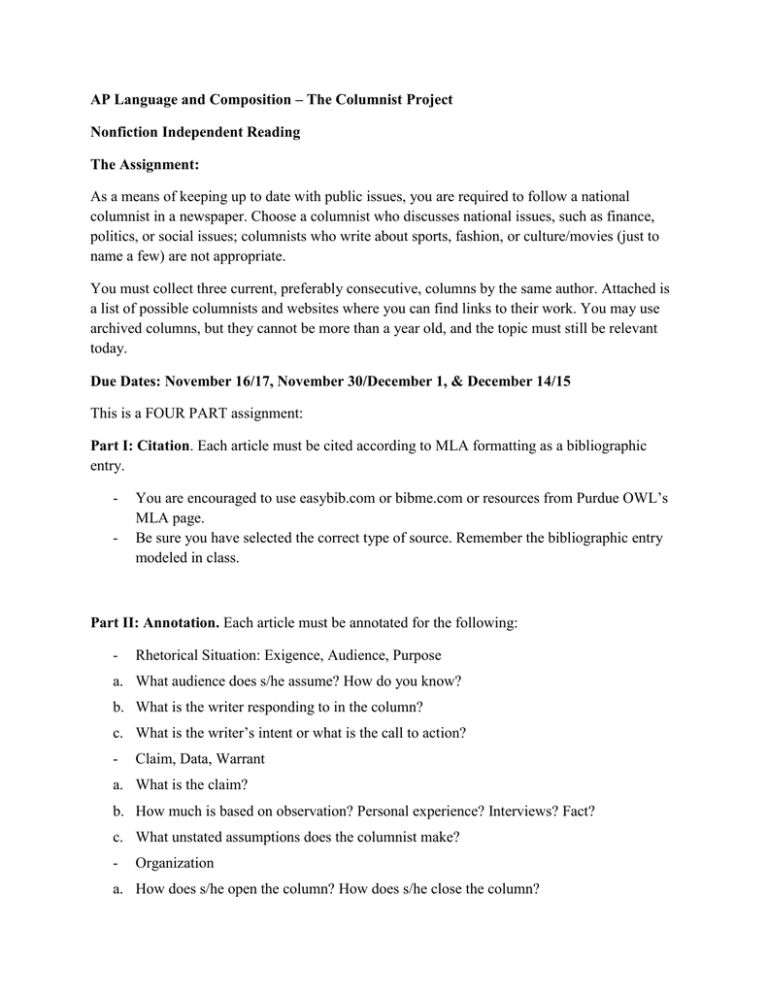
AP Language and Composition – The Columnist Project Nonfiction Independent Reading The Assignment: As a means of keeping up to date with public issues, you are required to follow a national columnist in a newspaper. Choose a columnist who discusses national issues, such as finance, politics, or social issues; columnists who write about sports, fashion, or culture/movies (just to name a few) are not appropriate. You must collect three current, preferably consecutive, columns by the same author. Attached is a list of possible columnists and websites where you can find links to their work. You may use archived columns, but they cannot be more than a year old, and the topic must still be relevant today. Due Dates: November 16/17, November 30/December 1, & December 14/15 This is a FOUR PART assignment: Part I: Citation. Each article must be cited according to MLA formatting as a bibliographic entry. - You are encouraged to use easybib.com or bibme.com or resources from Purdue OWL’s MLA page. Be sure you have selected the correct type of source. Remember the bibliographic entry modeled in class. Part II: Annotation. Each article must be annotated for the following: - Rhetorical Situation: Exigence, Audience, Purpose a. What audience does s/he assume? How do you know? b. What is the writer responding to in the column? c. What is the writer’s intent or what is the call to action? - Claim, Data, Warrant a. What is the claim? b. How much is based on observation? Personal experience? Interviews? Fact? c. What unstated assumptions does the columnist make? - Organization a. How does s/he open the column? How does s/he close the column? b. How soon does s/he announce the thesis? (inductive or deductive)? c. How does s/he organize? What are the parts or sections of the column? - Rhetorical Strategies: Syntax, Diction, Tone, Figurative Language, Appeals a. What sort of diction/word choice characterizes the columnist? b. What sort of syntax characterizes the columnist? c. What sort of tone does the speaker employ? Are tone shifts present? If so, what is their purpose? a. Mark places in the text that evoke a reaction from you, be it laughter, anger, or confusion. Part III: Précis [pray-see]. This must be typed. After annotating the column, write a FOURsentence précis, following the example given below: Précis instructions: When writing your précis, OBJECTIVELY summarize the article in your own words. Note: Before you begin writing your précis, ACTIVELY READ the column a number of times to make sure that you completely understand the author’s rhetorical and situation and argumentative stance. Part IV. Response. This must be typed. Below the précis, compose your one-paragraph SUBJECTIVE response, noting any questions, objections, or enlightenment generated by the article. Some questions you might want to consider are: - Do you agree or disagree with the editorial’s viewpoints? Why? - Did the editorial make you want to know more about the issue? - What are some of the author’s best arguments? What makes them valid? - Which arguments or points made by the author do not make sense to you? Why? - Which arguments or points made by the author are most effective to you? What makes them valid? Why? - How does this editorial connect with other knowledge that you have from other sources? - What patterns have you observed within the article? Bottom Line: 1) MLA bib entries 2) Annotated articles 3) Typed Précis 4) Typed Responses Due Nov. 16/17 Due Nov. 30/Dec. 1 Due Dec. 14/15 Example Précis 1. The first sentence identifies the essay’s author and title, provides the article’s date in parentheses, use some form of the verb “says” (claims, asserts, suggests, argues) followed by “that” and the essay’s thesis (paraphrased or quoted). - Example: In his “In Defense of Prejudice” (1995), Jonathan Rauch argues that prejudice in society should not be eliminated. 2. The second sentence describes the author’s support for the thesis, usually in chronological order. - Example: Rauch supports his position by providing anecdotal and historical evidence culled from segments of society which illustrates the futility and harm associated with attempts to eliminate prejudice. 3. The third sentence analyzes the author’s purpose using an “in order to” statement. - Example: Rauch hopes to shift the paradigm away from absolutism, the idea of punitive action against racism and prejudice, in order to move society toward rejection, the idea of societal pressure when grappling with racist and prejudicial attitudes. 4. The fourth sentence describes the essay’s intended audience and/or the relationship the author establishes with the audience. - Example: The author uses an erudite yet defensive tone, indicating that he primarily addresses a rather literal intellectual audience. Potential Columnists: The New York Times The New York Times The Washington Post The Washington Post Townhall The Daily Telegraph Maclean’s The Economist Time Newsweek The New Republic National Review The New Yorker Atlantic Monthly The Washington Post Stanley Fish David Leonhardt Ann Coulter Michelle Singletary Thomas Sowell Peggy Noonan David Horowitz Maureen Dowd Noam Chomsky Paul Krugman Thomas Friedman David Brooks David Broder George Will Fareed Zakaria
